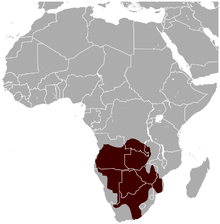South African springhare
hideThis article has multiple issues. Please help or discuss these issues on the talk page. (Learn how and when to remove these template messages)
|
| South African springhare | |
|---|---|

| |
| Scientific classification | |
| Kingdom: | Animalia |
| Phylum: | Chordata |
| Class: | Mammalia |
| Order: | Rodentia |
| Family: | Pedetidae |
| Genus: | Pedetes |
| Species: | P. capensis
|
| Binomial name | |
| Pedetes capensis (Forster, 1778)
| |

| |
| South African springhare range.[2] | |
| Synonyms | |
The South African springhare (Pedetes capensis) (Afrikaans: springhaas) is a large and unusual rodent. Despite the name, it is not a hare. It is one of two extant species in the genus Pedetes,[3] and is native to southern Africa. Formerly, the genus was considered monotypic and the East African springhare (P. surdaster) was included in P. capensis.[5][6]
Characteristics[]

The springhare resembles a small kangaroo, with well-developed hind legs, which allows it to leap over 2 m (6 ft 7 in) in a single bound. It gets its name from this ability. This animal grows to be around 35–45 cm (14–18 in) in length excluding its long tail, and weighs an average of 3 kg (6.6 lb). The tail adds to another 36–47 cm (14–19 in) in length. The colour of this mammal varies from a reddish-brown to a pale grey, with a black tip on the tail. The springhare lives only in south-eastern Africa, feeding on plant matter and even occasionally insects. They have four toes on their hind feet with claws that look like small hooves; these are wider than those found on the fore feet. They have a thick, muscular neck supporting their short head. They also have large eyes, and their ears have a tragus that prevents sand from entering when they are digging.[citation needed]
Springhares breed throughout the year. The females give birth to a single young about three times a year. Unlike some other rodents, which have blind and hairless young, springhares are born furred, and are active within a very short time of birth. However, they are not weaned and do not leave the burrow until they are about half grown. This extended period of parental care helps to mitigate a birthrate that is, among rodents, remarkably low.[7]
Behaviour[]
Springhares are mostly nocturnal, but are occasionally active in the day. During the daytime, they live in tunnels that they dig. They plug the entrance of the hole with soil from the inside of the tunnel. It is easier for them to dig during the rainy season when the soil is wet. Sometimes, they leap out of their burrows when they come out at night. The springhare jumps like a kangaroo on its hind legs, retreating to its burrow when frightened.[citation needed]
Springhares tend to only reside in any given burrow for a few consecutive days at most.[8] They tend to make three burrows together in a circular shape. These burrows are mostly found near the largest tree or bush within their home range. The springhare's home range is within 25 to 250 m (82 to 820 ft) of its burrow. It may expand its area during a drought.[citation needed]
The springhare's unoccupied burrows are sometimes used for hiding during the daytime by a number of other species, including the black-footed cat and the ground pangolin.[8]
The South African springhare is listed as a species of least concern by the IUCN.[2]
Gallery[]

Skull of a South African springhare

Biofluorescence in captive South African springhare
References[]
- ^ "Fossilworks: Yerbua capensis". fossilworks.org. Retrieved 2021-06-12.
- ^ Jump up to: a b c d Child, M.F. (2016). "Pedetes capensis (errata version published in 2017)". IUCN Red List of Threatened Species. 2016: e.T16467A115133584.
- ^ Jump up to: a b Dieterlen, F. (2005). "Family Pedetidae". In Wilson, D.E.; Reeder, D.M (eds.). Mammal Species of the World: A Taxonomic and Geographic Reference (3rd ed.). Johns Hopkins University Press. p. 1535. ISBN 978-0-8018-8221-0. OCLC 62265494.
- ^ Kingdon, Jonathan. (2013). Mammals of Africa. Happold, D. London: Bloomsbury Publishing. ISBN 978-1-4081-8996-2. OCLC 854973585.
- ^ Matthee, C. A. and Robinson, T. J. (1997). Mitochondrial DNA phylogeography and comparative cytogenetics of the springhare, Pedetes capensis (Mammalia: Rodentia). Journal of Mammalian Evolution 4: 53–73.
- ^ Matthee, C. A. and Robinson, T. J. (1997). Molecular phylogeny of the springhare, Pedetes capensis, based on mitochondrial DNA sequences. Molecular Biology and Evolution 14 (1): 20–29.
- ^ Butynski, Thomas M. (1984). Macdonald, D. (ed.). The Encyclopedia of Mammals. New York: Facts on File. pp. 634–635. ISBN 0-87196-871-1.
- ^ Jump up to: a b Relton, Claire; Child, Matthew; Avenant, Nico; Avery, Margaret; Baxter, Rod; Monadjem, Ara; Palmer, Guy; Taylor, Peter (Feb 2019). "Pedetes capensis – Springhare" (PDF). Mammal Red List 2016. Assessed by Dean Peinke; Assessed by Beryl Wilson; Reviewed by Corne Anderson. Endangered Wildlife Trust and South African National Biodiversity Institute. Retrieved 25 Apr 2020.
External links[]
| Wikimedia Commons has media related to Pedetes capensis. |
- IUCN Red List least concern species
- Pedetes
- Mammals of Zambia
- Mammals of Zimbabwe
- Mammals of Southern Africa
- Extant Zanclean first appearances
- Mammals described in 1778


